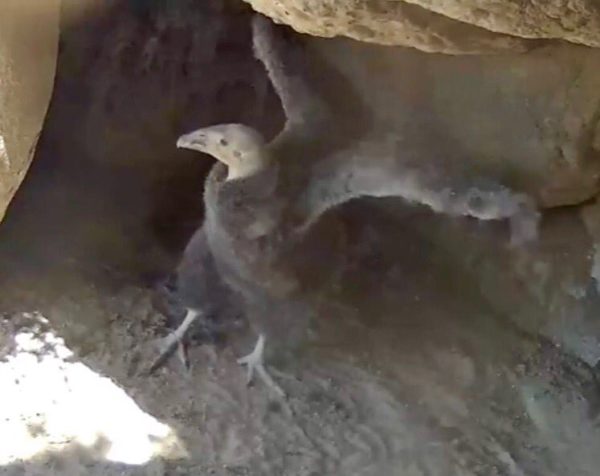
Live stream has been shared with millions of viewers
– People across the world can get up-close-and-personal with an endangered California condor chick in real-time through livestreaming video of a wild nest located near the U.S. Fish and Wildlife Service’s Hopper Mountain National Wildlife Refuge in Ventura County, California. The chick and its parents make up one of the 12 California condor nests in the mountains of Ventura, Santa Barbara, and Kern counties – the highest number of nests ever recorded in southern California.
“Watching a condor chick and its parents in the wild is a unique and remarkable experience and one that can be shared with millions of viewers through live streaming technology,” said Molly Astell, a wildlife biologist with the Service’s California Condor Recovery Program.
The 2018 nesting season marks a significant milestone for California condor recovery with more wild nests documented in southern California than ever recorded. “Not only do we have more nests, but they are also spread out across a broader area, indicating that California condors continue to expand back into parts of their historic range,” Astell said.
California condor chick #923 hatched on April 6 and is being raised by sixteen-year-old female condor #289 and thirteen-year-old male condor #374. This is the pair’s first year to be featured on the live streaming Condor Cam, and is the pair’s first attempt at raising a chick together, and both previously nested with other condors in the past. The chick’s father, condor #374 has fledged three other chicks in the past with two previous mates. The mother, condor #289, has fledged one chick previously and has nested with three other mates.
Followers of the California Condor Cam watched a chick hatch live in the wild for the first time in history from a cliffside nest at Hopper Mountain NWR in 2015. Since then, livestreaming video of California condor chicks at the refuge have gained worldwide attention – nearly two million views from more than 190 countries and 34 million minutes, or 65 years of watch time.
“Until now, only a handful of biologists had the privilege to observe wild condor nests. They had to trek into the remote backcountry and wait for days, sometimes weeks, at observation blinds located hundreds of feet from the nests to catch a glimpse of the birds,” says Dr. Estelle Sandhaus, the Santa Barbara Zoo’s director of conservation and science. “Today’s technology allows researchers like us to observe a number of nests with high precision – and in high def. That enables more efficient nest management and research for us, and allows anyone with an internet connection to share in the excitement of scientific discovery.”
Conservation efforts toward the recovery of the California condor are achieved only through partnerships amongst federal and state agencies, together with private land owners and other organizations. The Hutton’s Bowl Condor Cam is made possible through access provided by private landowners, and through the financial and technical support of the U.S. Fish and Wildlife Service, Santa Barbara Zoo, Cornell Lab of Ornithology, the Western Foundation of Vertebrate Zoology, Disney Conservation Fund, and Friends of California Condors Wild and Free.
In California, wild condors are found in the mountains of Monterey, San Benito, San Luis Obispo, Santa Barbara, Ventura, Los Angeles and Kern counties, and most recently in the western foothills of the Sierra Nevada Mountains in Tulare and Fresno counties. In 2017, California condors were spotted roosting in the western Sierras for the first time in nearly 40 years.
The number of California condors dropped dramatically in the mid-20th century, leading the Service to designate the species as endangered under the Endangered Species Act. By 1982 there were only 22 of the iconic birds left in the wild. Today, due to intensive, ongoing captive breeding and recovery efforts led by the Service in conjunction with multiple public and private partners, the California condor population has grown to around 470 birds worldwide, with more than half of the population flying free.
Today the number one killer of California condors is lead poisoning, caused by condors feeding on carcasses containing lead bullet fragments. Peer-reviewed research shows that lead poisoning is a serious health problem for both wildlife and humans, and the Service is working with partner organizations and the hunting community as it transitions to the use of non-lead ammunition alternatives. Hunters are continuing their proud tradition of wildlife conservation by using these non-lead alternatives.
Another threat specific to condor chicks is “micro trash.” Micro trash are small coin-sized trash items such as, nuts, bolts, washers, copper wire, plastic, bottle caps, glass, and spent ammunition cartridges. Condor parents collect these items and feed them to their chick which can cause serious problems with the chick’s development. While it is not completely understood why this occurs, many biologists believe that the condor parents mistake these items for pieces of bone and shell which provides a source of calcium if fed to the chick.
“Last year’s breeding season culminated in the first condor chick to fledge successfully from one of our livestreamed sites,” said Charles Eldermire, Cornell Bird Cams project leader. “We’re hoping we get to observe #923 taking that first leap from the nest ledge this year.”











